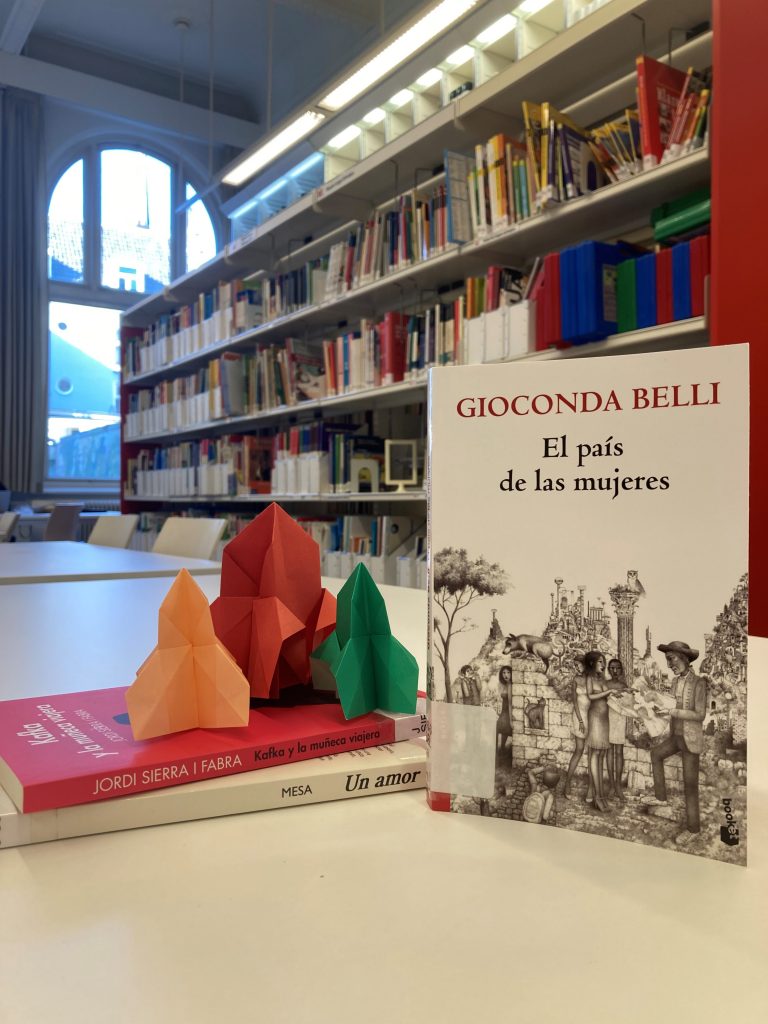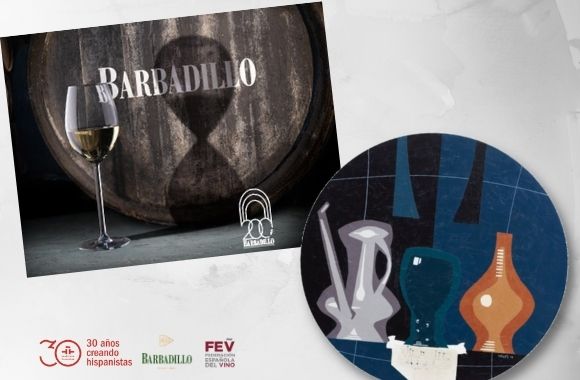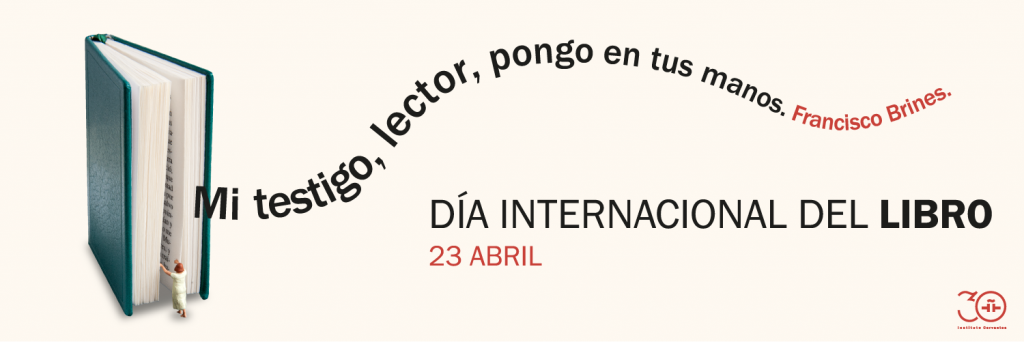Blog del Instituto Cervantes en Utrecht
Todo sobre nuestras actividades y servicios
Club de lectura: «El País de las mujeres»
Reseña realizada por Silvia Fallanti, miembro del Club de Lectura del Instituto Cervantes de Utrecht.
El País de las mujeres es una novela de la autora nicaragüense Gioconda Belli que se desarrolla en el País imaginario de Faguas. La protagonista de esta novela, la joven periodista Viviana Sansón, gana las elecciones con su Partido de la Izquierda Erótica (PIE). Con un atrevido programa electoral, Viviana despide todos los hombres de sus cargos laborales, y pone por la primera vez las mujeres al mando del gobierno. El objetivo de Viviana es convertir Faguas en un país mejor, apoyándose sobre el concepto de “Cuidadanía”, en lugar de él de ciudadanía. Con ese cambio drástico, Viviana quiere demostrar que los ciudadanos, y los políticos en particular, tendrían que cuidar su País come fuese su hijo. Ellos tendrían que limpiarlo como su casa, con la misma dedición que las mujeres demuestran cada día atendiendo a las tareas domésticas y a sus queridos. Viviana quiere plantear una sociedad en la que finalmente la inteligencia emocional de las mujeres vuelva a ser valorada. Sus partidarias junto a ella quieren demostrar que la renovación moral del País solamente puede empezar poniendo fin à la explotación de las mujeres.
Desde este punto de vista, hemos comentado que la novela se inspira en teorías feministas, aunque en el libro la política del PIE sea más bien descrita como una manifestación de “hembrismo”. De hecho, aprendimos que Viviana va leyendo el ensayo de Virginia Woolf “Un cuarto propio”. Ella se conmociona leyendo el fragmento en el que Woolf comenta que, si Shakespeare hubiese tenido una hermana con el mismo talento suyo, esa, por el hecho de ser mujer, nunca hubiera llegado a ser famosa en el mundo del teatro de su época. Sin embargo, hemos comentado en la tertulia como la novela simplifica demasiado la realidad social. Justamente definida “un cuento de hadas”, la novela se basa en estereotipos de lo que definimos como masculino o femenino. Además, no necesariamente todas las mujeres tienen ese espíritu de dedición idealizado por la autora. Por ese motivo hemos definido la novela también una utopía, que, como tal, utiliza la provocación y la exageración como estímulo para hacernos reflexionar sobre lo que significa hoy ser feministas. ¿Tenemos todavía necesidad de contraponer los dos géneros, hombres y mujeres? ¿O quizás sería mejor plantear el problema de forma distinta? Al final, los participantes en la tertulia hemos comentado que los cambios políticos no pueden realizarse sin un cambio cultural y de mentalidad más amplio, que presuponga una educación difusa en todos los niveles sociales. Sin ese acceso difuso a la educación, nunca se podrá convertir un País en un mundo mejor, a pesar de las teorías feministas.
La novela, al final, tiene que ser matizada a través del marco político y social de Nicaragua, y de la lucha política en favor de los derechos civiles y de la emancipación de las mujeres en este País que siempre ha acompañado la autora. Viviana paga un precio muy alto por su coraje político. En medio de un mitin, la líder del PIE es víctima de un atentado por mano de un opositor que le dispara una bala en el cráneo. Viviana se despierta del estado de coma después de varias semanas. A lo largo del coma Viviana tiene visiones que la hacen reflexionar sobre los momentos salientes de sus vidas, y también sobre los errores que ha cometido por ser demasiado impulsiva. Al regresar del coma, la líder del PIE toma la decisión de dimitir, lo que provoca una ola de protestaa pacíficas en el País para pedir que vuelva. Viviana reconoce que, gracias al PIE, Faguas se ha convertido en un País más rico y con más justicia social, y vuelve a la Presidencia. Pese a todo, ella reconoce que ha llegado el momento de que los hombres vuelvan al trabajo para alcanzar, juntos a las mujeres, una sociedad aún mejor. El “hembrismo” tiene que ser reemplazado por el “felicismo”. Porque, como dice Viviana al final de la novela, las utopías, que caracterizan el ser humano, son un largo camino que hay que realizarse juntos “un pie delante del otro”.
V Feria Cervantina del libro infantil y juvenil
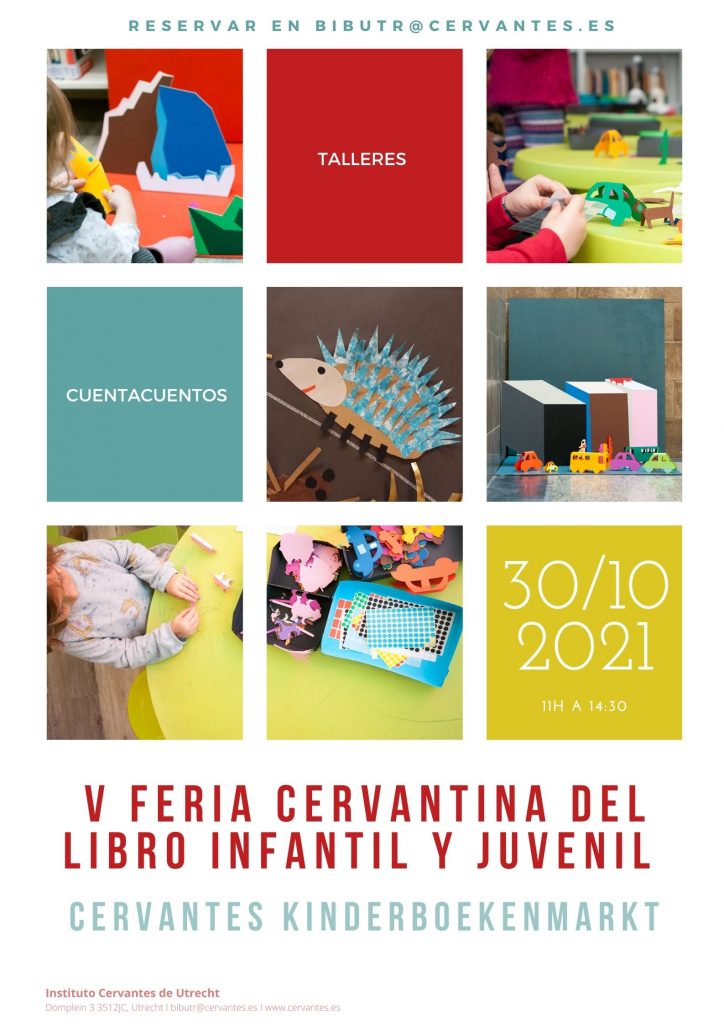
El 30 de octubre celebramos la ‘V Feria Cervantina del Libro Infantil y Juvenil’ en el Instituto Cervantes de Utrecht. Ven a acompañarnos en la gran aventura de la literatura infantil y juvenil en español.
A lo largo del día, pequeños y mayores descubriremos la magia de los libros, las últimas novedades editoriales y participaremos en diferentes actividades, cuentacuentos, talleres para dejar volar la imaginación…¡y mucho más!
Os esperamos en nuestras instalaciones para disfrutar de un programa repleto de actividades:
• De 11:00 a 11:30 Cuentacuentos para los más pequeños, por Asociación Mini Lectores. (Para niños de 2 a 4 años)
• De 11:30 a 14:30 Actividades conjuntas para adultos y niños por Asociación Lai.
• De 11:30 a 12:00 Teatro japonés de papel (kamishibai). Sesión de Narración oral para todos los públicos por Serendipity.
• De 12:15 a 13:00 Cuentacuentos del ilustrador y animador Daniel Tornero. Un artista polifacético con el que nos sumergiremos en universos mágicos de creación propia.
• 13:15 a 14:30 Taller de manualidades con Daniel Tornero en el que elaboraremos un mural.
¡Además tendréis la oportunidad de comprar libros durante todo el evento!
Op 30 oktober organiseren we de vijfde «Cervantes Kinder- en Jeugdboekenmarkt» in het Instituto Cervantes te Utrecht. Ga met ons mee op avontuur door de Spaantalige kinder- en jeugdliteratuur. De hele dag door ontdekken jong en oud de magie van boeken, bekijken we de nieuwe titels en nemen we deel aan verschillende activiteiten, voorleessessies, workshops om onze fantasie de vrije loop te laten… en nog veel meer!
We nodigen u graag op ons instituut om te genieten van een programma vol activiteiten:
• Van 11:00 tot 11:30 Verhalen voor de allerkleinsten, door de vereniging Asociación Mini Lectores. (Voor kinderen van 2 tot 4 jaar)
• Van 11.30 tot 14.30 uur Gezamenlijke activiteiten voor volwassenen en kinderen door Lai Association.
• Van 11.30 tot 12.00 uur Japans papiertheater (kamishibai). Mondelinge vertelsessie voor alle leeftijden door Serendipity.
• Van 12:15 tot 13:00 Voorleessessie door illustrator en acteur Daniel Tornero. Een veelzijdige artiest met wie we ons zullen onderdompelen in magische werelden van onze eigen creatie.
• 13:15 tot 14:30 Schilderworkshop met Daniel Tornero waarin we een muurschildering gaan maken.
Gedurende de hele dag is het ook de mogelijk om boeken te kopen.
¡Disfruta del vino y del arte!
El Instituto Cervantes le invita a participar en esta actividad que tendrá lugar el 16 de septiembre 2021
A las 17:00 horas podrá disfrutar de la conferencia Cultura en una botella a cargo del escritor y conferenciante Andrés Pascual, quien les abrirá las puertas a un universo fascinante de obras de arte y libros salpicados de vino. Al término de la conferencia tendrá lugar una cata de vinos de Bodegas Barbadillo, en colaboración con la Federación Española del Vino. Bodegas Barbadillo es una bodega familiar fundada en Sanlúcar de Barrameda, en el sur de España, en 1821.
A las 19:00 tendrá lugar la inauguración de la exposición Naturaleza muerta con brida. Homenaje a Torrentius del artista español Lluis Ventós. Una muestra que reinterpreta en claves contemporáneas la obra Naturaleza muerta con brida del misterioso artista neerlandés del siglo XVII, Torrentius. Además verán el documental Cold Case Torrentius (2016) con una introducción a cargo de Maarten de Kroon, director del mismo.
Para participar deben reservar su planza enviando un correo con su nombre y apellidos y los de su acompañante a: cultutr@cervantes.es
KOM 16 SEPTEMBER GENIETEN VAN WIJN EN KUNST!
Het Instituto Cervantes nodigt u uit om deel te nemen aan onze activiteiten.
Om 17.00 uur beginnen we met de conferentie «Cultuur in een fles» door de schrijver en docent Andrés Pascual, die u alles zal vertellen over de fascinerende wereld van kunstwerken en boeken besprenkeld met wijn. Aan het eind van de conferentie is er een wijnproeverij door Bodegas Barbadillo, in samenwerking met de Spaanse Wijnfederatie. Bodegas Barbadillo is een familiewijnhuis dat in 1821 in Sanlúcar de Barrameda, in Zuid-Spanje, is opgericht.
Om 19.00 uur openen we de tentoonstelling «Naturaleza muerta con brida. Hommage aan Torrentius» van de Spaanse kunstenaar Lluis Ventós. Een tentoonstelling die het werk «Stilleven met breidel» van de mysterieuze Nederlandse kunstenaar Torrentius uit de zeventiende eeuw opnieuw bekijkt met een moderne blik. Daarna kunt u kijken naar de documentaire «Cold Case Torrentius» (2016) met een inleiding van Maarten de Kroon, regisseur van de documentaire.
Om deel te nemen dient u uw plaats te reserveren door een e-mail te sturen met uw naam en achternaam naar: cultutr@cervantes.es
Crónica de una asignatura / De kroniek van een vak / A chronicle of a course
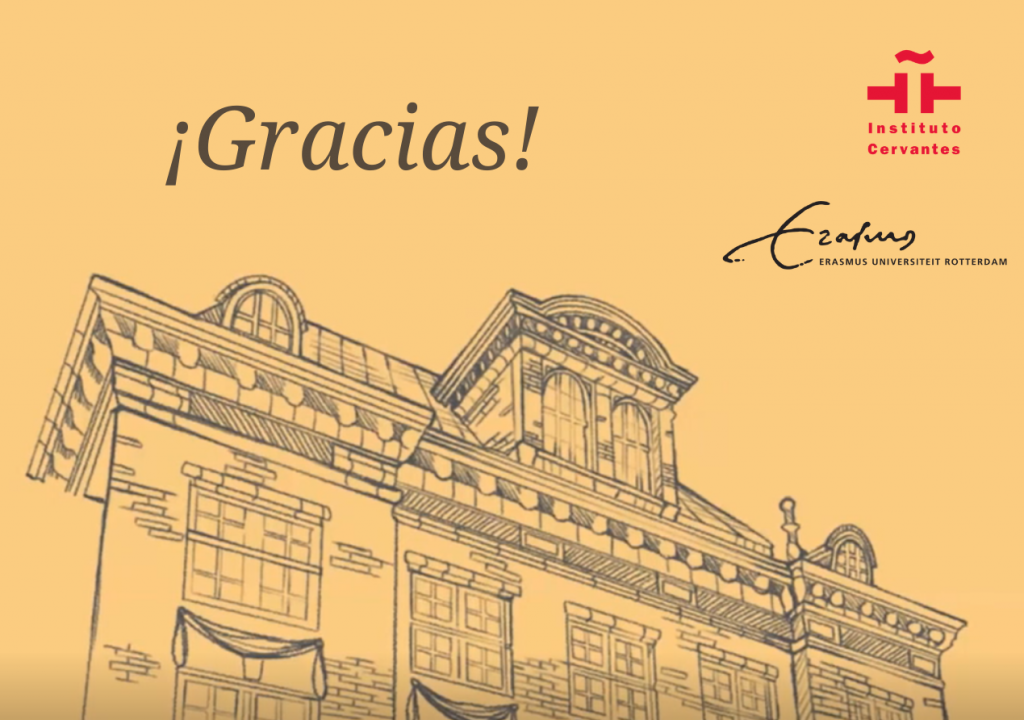
Este año, el Instituto Cervantes de Utrecht ha tenido el placer y la fortuna de ser el foco de estudio de los alumnos de la asignatura Introduction to cultural policy de la Universidad de Erasmus de Róterdam, bajo la supervisión de dr. FJC Brouwer. El objetivo de esta materia era “desarrollar una estrategia política sólida para promover el estudio y la práctica del español en los Países Bajos a todos los niveles.” [1]
Durante ocho semanas, los alumnos han estudiado intensamente la labor del Instituto Cervantes de Utrecht, su posición en los Países Bajos, sus puntos fuertes y débiles, sus actividades, etc. En definitiva, han llegado a conocer el Instituto casi tanto como los que formamos parte de él.
También han analizado la posición de idioma español en este país, ¡y es muy popular! Desde que es posible estudiarlo en la educación secundaria, cada año más alumnos se animan a aprender este idioma. Es la lengua preferida del 42% de los jóvenes neerlandeses y la primera opción a elegir como destino del Erasmus (¡y no creemos que sea solo por las tapas!).
De su gran labor de investigación han salido numerosos e interesantes trabajos en los que los alumnos, organizados en grupos, expresaban su visión del Instituto y daban recomendaciones. Además, cada grupo estudió la política cultural de España y otro país de América Latina.
Los nueve grupos que hicieron los mejores trabajos tuvieron la oportunidad de presentarlos ante el siguiente jurado, que elegiría al grupo ganador:
• Pilar Tena, directora del Instituto Cervantes de Utrecht
• Marielies Schelhaas, Secretaria General de la Comisión nacional neerlandesa de UNESCO
• Arnoldo Brenes Castro, Embajador de Costa Rica en los Países Bajos
• Mikko Fritze, Director del Goethe-Institut Netherlands
Durante sus presentaciones los alumnos superaron todas las expectativas y sorprendieron al jurado. A través de videos hechos por ellos mismos (si pinchas aquí podrás ver, por ejemplo, el del grupo llamado Cuba #1) y sobre todo con mucho entusiasmo, expresaron sus ideas de la manera en la que lo habría hecho una consultoría profesional.
Abrumados por la originalidad de las propuestas, el jurado tuvo grandes dificultades eligiendo al ganador. Al final el grupo premiado fue Perú, que había salido a las calles de Utrecht a pedir a neerlandeses que pronunciaran palabras como “hijastro” o “correcaminos” y propusieron la creación de una app llamada “Cervantastic” (que contaría con clases online, lecciones de cocina y mucho más).
Entre otras propuestas encontramos traducir la página web al inglés o dirigir un proyecto de Pen-Pal. También nos describieron cómo mejorar nuestra presencia online o la importancia de Spotify. Hemos acogido todas las ideas (¡no solo las de los nueve grupos finalistas!), las estamos analizando y sin duda pondremos en marcha algunas de ellas.
Desde el Instituto Cervantes nos sentimos agradecidos, impresionados y más que satisfechos con el trabajo realizado. Creemos que es imprescindible escuchar lo que las nuevas generaciones tienen que decir y que aportar. Al igual que el idioma español, son el futuro, y su aportación tiene un valor incalculable.
¡Gracias! Bedankt!
[1] dr.FJC Brouwer, Syllabus Introduction to Cultural Policy (CC1006). Erasmus Universiteit Rotterdam, 2020.
NEDERLANDS
De kroniek van een vak
Het Instituto Cervantes in Utrecht heeft dit jaar het genoegen gehad om het onderzoeksonderwerp te zijn voor de studenten van de Erasmus Universiteit in Rotterdam binnen het vak Introduction to cultural policy, onder begeleiding van Dr. F.J.C. Brouwer. Het doel van dit vak was «het ontwikkelen van een solide politieke strategie om het onderwijs en gebruik van de Spaans taal in Nederland op alle niveaus te bevorderen».[1]
Gedurende acht weken hebben de studenten het werk van het Instituto Cervantes in Utrecht aandachtig onderzocht: de positie in Nederland, de sterke en zwakke punten, de activiteiten, enz.. Kortom, ze hebben het Instituto bijna net zo goed leren kennen als degenen die er werken.
Ze hebben ook gekeken naar de positie van de Spaanse taal in Nederland, en ze zijn erachter gekomen dat het een erg populaire taal is! Sinds de mogelijkheid bestaat om voor Spaans te kiezen op de middelbare school, maken elk jaar steeds meer leerlingen deze keuze. 42% van de jonge Nederlanders vindt Spaans de leukste vreemde taal en Spanje staat op de eerste plaats als Erasmusbestemming (en we denken niet dat het alleen vanwege de tapas komt!).
Dit belangrijke onderzoekswerk heeft geresulteerd in vele interessante papers waarin de studenten, verdeeld in werkgroepen vernoemd naar Spaanstalige landen, hun visie op het instituut hebben gegeven en aanbevelingen hebben gedaan. Daarnaast heeft elke groep het cultuurbeleid van Spanje en een ander Latijns-Amerikaans land onderzocht.
De negen groepen die de beste papers schreven, kregen de kans hun voorstel te presenteren aan deze jury, die vervolgens de winnende groep zou kiezen:
- Pilar Tena, directeur van het Instituto Cervantes in Utrecht
- Marielies Schelhaas, secretaris-generaal van de Nederlandse Nationale Commissie van UNESCO
- Arnoldo Brenes Castro, ambassadeur van Costa Rica in Nederland
- Mikko Fritze, directeur van het Goethe-Institut Nederland
Tijdens hun presentaties overtroffen de studenten alle verwachtingen en verrasten ze de jury. Via zelfgemaakte video’s (als je hier klikt kun je bijvoorbeeld de video van de Cuba # 1-groep zien) toonden ze vooral met veel enthousiasme hun ideeën zoals ook een professioneel adviesbureau het zou hebben gedaan.
Overweldigd door de originaliteit van de voorstellen, had de jury grote moeite om de winnaar te kiezen. Uiteindelijk werd Peru de winnende groep. Zij waren de straten van Utrecht was opgegaan om Nederlanders te vragen woorden uit te spreken als «hijastro[2]» of «correcaminos[3]«. Ze stelden ook voor om een app te maken met de naam «Cervantastic» (met online lessen, kooklessen en nog veel meer).
Andere voorstellen waren onder meer het vertalen van de website in het Engels of het runnen van een Pen-Pal-project. Ze hebben ook beschreven hoe we onze online aanwezigheid of het belang van Spotify kunnen verbeteren. We hebben alle ideeën verzameld (niet alleen die van de negen finalisten!), we zijn druk bezig ze te analyseren en we zullen er zeker een aantal uitvoeren.
Wij van het Instituto Cervantes zijn erg dankbaar, onder de indruk en meer dan tevreden over het werk dat de studenten hebben verricht. Wij vinden het erg belangrijk te luisteren naar wat de nieuwe generaties te zeggen hebben en we willen weten wat hun ideeën zijn. Net als de Spaanse taal zijn zij de toekomst, en hun bijdrage is van onschatbare waarde. Bedankt!
[1] dr.FJC Brouwer, Syllabus Introduction to Cultural Policy (CC1006). Erasmus Universiteit Rotterdam, 2020.
[2] “Hijastro” betekent “stiefzoon”
[3] “Correcaminos” is de Spaanse naam van het Warner Brothers figuur the Road Runner
INGLÉS
A chronicle of a course
This year, the Instituto Cervantes in Utrecht has had the pleasure of being the focus of study by the students of the course Introduction to cultural policy at the Erasmus University Rotterdam, under the supervision of Dr. FJC Brouwer. The aim of the course was “to develop a sound political strategy to promote the study and practice of Spanish in the Netherlands at all levels”[1].
During eight weeks, the students have intensively studied the work of the Instituto Cervantes in Utrecht, its position in the Netherlands, its strengths and weaknesses, its activities, etc. In short, they got to know the Instituto almost as well as those who are part of it.
They have also analysed the position of the Spanish language in this country, and it is very popular! Since it has been possible to study Spanish in secondary education, more and more students choose to learn this language every year. It is the preferred language of 42% of young Dutch people and Spain is the first choice as an Erasmus destination (and we don’t think it’s just because of the tapas!).
A lot of interesting research work has resulted in many fascinating papers in which the students, organised in groups, expressed their vision of the Institute and gave recommendations. In addition, each group studied the cultural policy of Spain and another Latin American country.
The nine groups that produced the best papers had the opportunity to present them to the following jury, which would choose the winning group:
- Pilar Tena, Director of the Instituto Cervantes in Utrecht
- Marielies Schelhaas, Secretary General of the Dutch National Commission of UNESCO
- Arnoldo Brenes Castro, Ambassador of Costa Rica to the Netherlands
- Mikko Fritze, Director of the Goethe-Institut Netherlands
During their presentations the students exceeded all expectations and surprised the jury. Through self-made videos (if you click here you can see, for example, the video of the Cuba #1 group) and above all with a lot of enthusiasm, they expressed their ideas in the way a professional consultancy would have done it.
Overwhelmed by the originality of the proposals, the jury had great difficulty choosing the winner. In the end the winning group was Peru, who had gone to the streets of Utrecht to ask Dutch people to pronounce words such as «hijastro[2]» or «correcaminos[3]«. They also proposed the creation of an app called «Cervantastic» (which would feature online classes, cooking lessons and much more).
Other proposals included translating the website into English or running a Pen-Pal project. They also described how to improve our online presence or the importance of Spotify. We have welcomed all the ideas (not only those of the nine finalist groups!), we are analysing them and we will certainly implement some of them.
We at the Instituto Cervantes are very grateful, impressed and more than satisfied with the work that the students have done. We believe that it is essential to listen to what the new generations have to say and to their proposals. Like the Spanish language, they are the future, and their contribution is of incalculable value.
Thank you! Bedankt!
[1] dr.FJC Brouwer, Syllabus Introduction to Cultural Policy (CC1006). Erasmus Universiteit Rotterdam, 2020.
[2] “Hijastro” means “stepson”
[3] “Correcaminos” is the Spanish name of the Warner Brothers character the Road Runner
Día del libro / Wereldboekendag 2021
En el Día Internacional del Libro 2021 nos vamos a centrar en la figura de Antonio Machado, uno de los poetas más importantes e influyentes de España. Para ello hemos preparado un programa especial con la colaboración de la Fundación Antonio Machado y con Summer Films.
El 23 de abril a las 16:00 comenzaremos con una actividad infantil titulada “El sol es un globo rojo”. A las 17:30 disfrutaremos de un interesante y enriquecedor coloquio sobre el poeta, y a las 20:00 podremos ver un bellísimo documental sobre la historia y vigencia de la obra de Machado.
Sin embargo, que dediquemos el Día Internacional del Libro al poeta sevillano no significa que nos hayamos olvidado del escritor que da nombre a nuestra institución. Para celebrar a Cervantes y al Quijote, este año hemos decidido mirar hacia atrás. ¿Cómo se celebraba la figura del Quijote en 1905? ¿A quién se le ocurrió la idea de celebrar el aniversario de la publicación de un libro por primera vez? ¿Por qué celebramos el Día del libro el 23 de abril?
Hemos preparado un artículo en español e inglés con respuestas a estas preguntas y mucho más. Lo encontrarás en el siguiente enlace.
¡Feliz lectura!
Dit jaar op Wereldboekendag 2021 staat de figuur Antonio Machado centraal, één van Spanje’s belangrijkste en meest invloedrijke dichters. We hebben daarvoor een speciaal programma samengesteld in samenwerking met de Fundación Antonio Machado en Summer Films.
Op 23 april starten we om 16:00 uur met een kinderactiviteit getiteld “De zon is een rode ballon”. Om 17:30 uur kunnen we genieten van een boeiend en informatief gesprek over de dichter, en om 20:00 uur begint een prachtige documentaire over de geschiedenis en de universele waarde van het werk van Machado.
Alhoewel Wereldboekendag is gewijd aan Antonio Machado, betekent dit niet dat we voorbij gaan aan de schrijver die ons instituut zijn naam gaf. Om Cervantes en Don Quichot te eren, hebben we besloten dit jaar terug te kijken: Op welke manier werd Don Quichot herdacht in 1905? Wie kwam voor het eerst op het idee om de herdenkingsdag van de publicatie van een boek te vieren? Waarom vieren we de Dag van het Boek op 23 april?
We hebben een artikel gemaakt in zowel het Spaans als het Engels met de antwoorden op deze vragen en nog veel meer. Je kunt het vinden in de volgende link.
Veel leesplezier!
This year, on International Book Day 2021, we are going to focus on the figure of Antonio Machado, one of Spain’s most important and influential poets. To do so, we have prepared a special programme in collaboration with the Antonio Machado Foundation and with Summer Films.
We will start at 4 pm on 23rd April with a children’s activity called «The sun is a red balloon». At 5:30 pm we will enjoy an interesting and informative conversation about the poet and at 8 pm we will be able to watch a beautiful documentary about the history and current relevance of Machado’s work.
However, the fact that we are dedicating International Book Day to Antonio Machado does not mean that we have forgotten the writer after whom our institution is named. To celebrate Cervantes and Don Quixote, this year we have decided to look back in time: how was Don Quixote honoured in 1905? Who came up with the idea of celebrating the anniversary of the publication of a book for the first time? Why do we celebrate Book Day on 23rd April?
We have prepared an article both in Spanish and English with the answers to these questions and much more. You will find it in the following link.
Happy reading!
